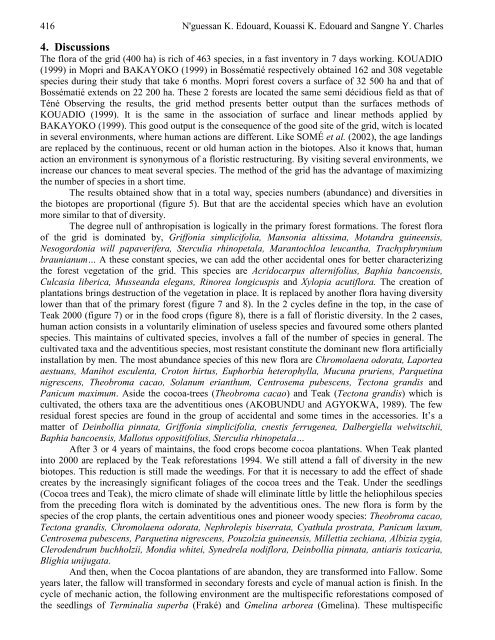European Journal of Scientific Research - EuroJournals
European Journal of Scientific Research - EuroJournals
European Journal of Scientific Research - EuroJournals
Create successful ePaper yourself
Turn your PDF publications into a flip-book with our unique Google optimized e-Paper software.
416 N'guessan K. Edouard, Kouassi K. Edouard and Sangne Y. Charles<br />
4. Discussions<br />
The flora <strong>of</strong> the grid (400 ha) is rich <strong>of</strong> 463 species, in a fast inventory in 7 days working. KOUADIO<br />
(1999) in Mopri and BAKAYOKO (1999) in Bossématié respectively obtained 162 and 308 vegetable<br />
species during their study that take 6 months. Mopri forest covers a surface <strong>of</strong> 32 500 ha and that <strong>of</strong><br />
Bossématié extends on 22 200 ha. These 2 forests are located the same semi décidious field as that <strong>of</strong><br />
Téné Observing the results, the grid method presents better output than the surfaces methods <strong>of</strong><br />
KOUADIO (1999). It is the same in the association <strong>of</strong> surface and linear methods applied by<br />
BAKAYOKO (1999). This good output is the consequence <strong>of</strong> the good site <strong>of</strong> the grid, witch is located<br />
in several environments, where human actions are different. Like SOMÉ et al. (2002), the age landings<br />
are replaced by the continuous, recent or old human action in the biotopes. Also it knows that, human<br />
action an environment is synonymous <strong>of</strong> a floristic restructuring. By visiting several environments, we<br />
increase our chances to meat several species. The method <strong>of</strong> the grid has the advantage <strong>of</strong> maximizing<br />
the number <strong>of</strong> species in a short time.<br />
The results obtained show that in a total way, species numbers (abundance) and diversities in<br />
the biotopes are proportional (figure 5). But that are the accidental species which have an evolution<br />
more similar to that <strong>of</strong> diversity.<br />
The degree null <strong>of</strong> anthropisation is logically in the primary forest formations. The forest flora<br />
<strong>of</strong> the grid is dominated by, Griffonia simplicifolia, Mansonia altissima, Motandra guineensis,<br />
Nesogordonia will papaverifera, Sterculia rhinopetala, Marantochloa leucantha, Trachyphrymium<br />
braunianum… A these constant species, we can add the other accidental ones for better characterizing<br />
the forest vegetation <strong>of</strong> the grid. This species are Acridocarpus alternifolius, Baphia bancoensis,<br />
Culcasia liberica, Musseanda elegans, Rinorea longicuspis and Xylopia acutiflora. The creation <strong>of</strong><br />
plantations brings destruction <strong>of</strong> the vegetation in place. It is replaced by another flora having diversity<br />
lower than that <strong>of</strong> the primary forest (figure 7 and 8). In the 2 cycles define in the top, in the case <strong>of</strong><br />
Teak 2000 (figure 7) or in the food crops (figure 8), there is a fall <strong>of</strong> floristic diversity. In the 2 cases,<br />
human action consists in a voluntarily elimination <strong>of</strong> useless species and favoured some others planted<br />
species. This maintains <strong>of</strong> cultivated species, involves a fall <strong>of</strong> the number <strong>of</strong> species in general. The<br />
cultivated taxa and the adventitious species, most resistant constitute the dominant new flora artificially<br />
installation by men. The most abundance species <strong>of</strong> this new flora are Chromolaena odorata, Laportea<br />
aestuans, Manihot esculenta, Croton hirtus, Euphorbia heterophylla, Mucuna pruriens, Parquetina<br />
nigrescens, Theobroma cacao, Solanum erianthum, Centrosema pubescens, Tectona grandis and<br />
Panicum maximum. Aside the cocoa-trees (Theobroma cacao) and Teak (Tectona grandis) which is<br />
cultivated, the others taxa are the adventitious ones (AKOBUNDU and AGYOKWA, 1989). The few<br />
residual forest species are found in the group <strong>of</strong> accidental and some times in the accessories. It’s a<br />
matter <strong>of</strong> Deinbollia pinnata, Griffonia simplicifolia, cnestis ferrugenea, Dalbergiella welwitschii,<br />
Baphia bancoensis, Mallotus oppositifolius, Sterculia rhinopetala…<br />
After 3 or 4 years <strong>of</strong> maintains, the food crops become cocoa plantations. When Teak planted<br />
into 2000 are replaced by the Teak reforestations 1994. We still attend a fall <strong>of</strong> diversity in the new<br />
biotopes. This reduction is still made the weedings. For that it is necessary to add the effect <strong>of</strong> shade<br />
creates by the increasingly significant foliages <strong>of</strong> the cocoa trees and the Teak. Under the seedlings<br />
(Cocoa trees and Teak), the micro climate <strong>of</strong> shade will eliminate little by little the heliophilous species<br />
from the preceding flora witch is dominated by the adventitious ones. The new flora is form by the<br />
species <strong>of</strong> the crop plants, the certain adventitious ones and pioneer woody species: Theobroma cacao,<br />
Tectona grandis, Chromolaena odorata, Nephrolepis biserrata, Cyathula prostrata, Panicum laxum,<br />
Centrosema pubescens, Parquetina nigrescens, Pouzolzia guineensis, Millettia zechiana, Albizia zygia,<br />
Clerodendrum buchholzii, Mondia whitei, Synedrela nodiflora, Deinbollia pinnata, antiaris toxicaria,<br />
Blighia unijugata.<br />
And then, when the Cocoa plantations <strong>of</strong> are abandon, they are transformed into Fallow. Some<br />
years later, the fallow will transformed in secondary forests and cycle <strong>of</strong> manual action is finish. In the<br />
cycle <strong>of</strong> mechanic action, the following environment are the multispecific reforestations composed <strong>of</strong><br />
the seedlings <strong>of</strong> Terminalia superba (Fraké) and Gmelina arborea (Gmelina). These multispecific

















